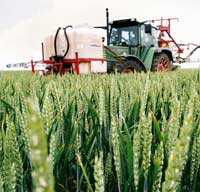Cereals 2009: Contract farming returns rise

Contract farming results released by Bidwells Agribusiness at Cereals 2009 show a 15% increase in net profit for the 2008 harvest, to £552/ha (£223/acre) before payment of the farmer’s prior charge.
This compares with 479/ha (£194/acre) in 2007 on the back of low yields and high prices across the 90 agreements managed by the firm.
Average profit share for the contractor rose to £208/ha (£84/acre) in 2008, up 15% from £180/ha (£73/acre) in 2007 while the farmer’s share of profits rose from £102/ha (£41/acre) in 2007 to £132/ha (£54/acre) in 2008. This represents a 29% increase while overall return to the farmer in 2008 rose by 13%.
The majority of agreements award the contractor 70% to 80% of the first tier of any surplus after paying the farmer’s prior charge, the contracting fee and variable costs.
Most agreements now include a second tier of profit shared on a 50/50 basis and a handful go to a third tier, which swings back in favour of the farmer to account for the odd year of exceptionally high profit.
The average cost of contracting across all crops and land left fallow or in stewardship fell slightly in 2008 to £236/ha (£95/acre). This is the second year of reduction, although in general contracting rates are increasing, says David Cousins, head of farm management at Bidwells Agribusiness.
“Agreements that were negotiated in the run up to harvest last year generally saw an increase in the contract rates in response to the rising cost of fuel oil and many now include a sliding scale for contract rates dependent upon the fuel price. Average cost fell in 2008 because the area of sugar beet and root crops within the survey has fallen.
Summary results – Bidwells contract farming agreements
2007 harvest | 2008 harvest | 5-year average | |
(All figures in £/acre) | |||
Profit share to farmer | 41 | 54 | |
Profit share to contractor | 73 | 84 | |
Total return to farmer | 125 | 141 | 106 |
Total return to contractor | 178 | 183 | 149 |
“Harvest 2008 was one of high yields and more modest market values. Record breaking fuel prices meant fixed costs rose significantly, but in the main high yield offset lower values and increased costs. Sound agronomic and marketing policies combined with pro-active management produced the best results,” says Mr Cousins.
However 2008 saw greater than usual variability in results across farms in yield and quality, depending on location, soil type and weather pattern, and in financial terms depending on when crops were sold.
Cereal yields were some of the best on record, particularly on lighter land. That the majority of grain had to be dried was a tremendous challenge to an ageing and perhaps inadequate farm storage infrastructure, says Mr Cousins. “It was not only wet but higher volume and stretched all the logistics.”
Cropping is dominated by cereals and oilseeds and although some farms in the sample grow roots, the results for 2008 reflect a slight drop in this acreage. Results include Single Farm Payment and Environmental Stewardship Scheme income relating to the land within the agreements.
A weaker sterling meant Single Farm Payments on average were 14% higher in 2008 than 2007, but as a proportion of net profit, the SFP was constant at 40%. While total income increased by 15% over the year, variable costs increased by 16% and gross margin by 14%.
Looking ahead, Mr Cousins is clear that there is room for some confidence that wheat prices will rise.
“Food security remains at the top of most political agendas. World supply and demand equation effectively moved from deficit to surplus in one season on the back of the 2008 harvest and it is this fine balance and the fact that world stocks have become so depleted in recent years that underpins market price volatility.
“The credit squeeze has not affected production in UK to the same extent as some regions, where securing inputs in the absence of cash and credit is a real problem, for example in Russia and the Ukraine.”
Other factors influencing future performance include:
- • What degree of political interference there might be to keep food price inflation at bay
- • Length and depth of the recession – agriculture tends to be relatively recession-proof as food is less discretionary than most purchases
- • Farmers’ ability to manage risk by to cope with volatility
- • Fuel prices likely to rise in the long term
- • CAP reform – radical change in 2013 unlikely — replacement for current SFP will probably continue to be area based payment gradually tapering off to 2020.

